- Home
- About
- Map
- Trips
- Bringing Boat West
- Migration West
- Solo Motorcycle Ride
- Final Family XC Trip
- Colorado Rockies
- Graduates' XC Trip
- Yosemite & Nevada
- Colorado & Utah
- Best of Utah
- Southern Loop
- Pacific Northwest
- Northern Loop
- Los Angeles to NYC
- East Coast Trips
- Martha's Vineyard
- 1 Week in Quebec
- Southeast Coast
- NH Backpacking
- Martha's Vineyard
- Canadian Maritimes
- Ocracoke Island
- Edisto Island
- First Landing '02
- Hunting Island '02
- Stowe in Winter
- Hunting Island '01
- Lake Placid
- Chesapeake
- Provincetown
- Hunting Island '00
- Acadia in Winter
- Boston Suburbs
- Niagara Falls
- First Landing '99
- Cape Hatteras
- West Coast Trips
- Burning Man
- Utah Off-Roading
- Maui
- Mojave 4WD Course
- Colorado River Rafting
- Bishop & Death Valley
- Kauai
- Yosemite Fall
- Utah Off-Road
- Lost Coast
- Yosemite Valley
- Arizona and New Mexico
- Pescadero & Capitola
- Bishop & Death Valley
- San Diego, Anza Borrego, Joshua Tree
- Carmel
- Death Valley in Fall
- Yosemite in the Fall
- Pacific Northwest
- Utah Off-Roading
- Southern CA Deserts
- Yosemite & Covid
- Lake Powell Covid
- Eastern Sierra & Covid
- Bishop & Death Valley
- Central & SE Oregon
- Mojave Road
- Eastern Sierra
- Trinity Alps
- Tuolumne Meadows
- Lake Powell Boating
- Eastern Sierra
- Yosemite Winter
- Hawaii
- 4WD Eastern Sierra
- 4WD Death Valley +
- Southern CA Deserts
- Christmas in Tahoe
- Yosemite & Pinnacles
- Totality
- Yosemite & Sierra
- Yosemite Christmas
- Yosemite, San Diego
- Yosemite & North CA
- Seattle to Sierra
- Southwest Deserts
- Yosemite & Sierra
- Pacific Northwest
- Yosemite & South CA
- Pacific Northwest
- Northern California
- Southern Alaska
- Vancouver Island
- International Trips
- Index
- Tips
- Books
- Photos/Videos
- Search
- Contact
Bodie State Historic Park, CA
Saturday, September 16, 2017 - 2:45pm by Lolo
32 miles and 1.5 hours from our last stop
Travelogue
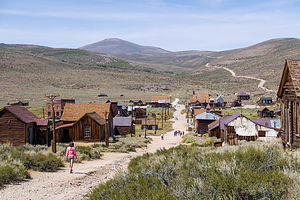 Bodie Ghost TownWe had been to Bodie State Historical Park once before, but this time we would approach it the way the old prospectors did - over a mountain on a rough backcountry road past abandoned mines, and even a genuine cattle drive, but I’ll get to that later.
Bodie Ghost TownWe had been to Bodie State Historical Park once before, but this time we would approach it the way the old prospectors did - over a mountain on a rough backcountry road past abandoned mines, and even a genuine cattle drive, but I’ll get to that later.
Rather than taking 395 south to the the paved 270 into Bodie, we headed north and turned onto Masonic Road. From here, we spent the next 32 miles driving up and down the rolling Bodie Hills, past old ghost towns and abandoned mines, with sweeping views of the Sierra and the Sweetwater Mountains all along the way. It was breathtaking.
Like ski runs,4WD roads are graded in terms of difficulty - Green for Easy, Blue for Intermediate, and Black for “no thank you.” This was a Green and the 4Runner handled it like a champ.
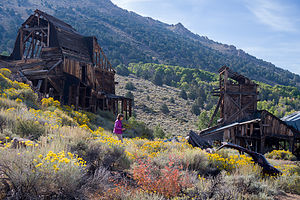 Abandoned mine along the road to BodieWe stopped several times along the way to wander amongst the old mining sites, many of which still had quite a few structures and equipment to poke around. It was really fascinating to imagine what a bustling place this must have been during the heyday of the Gold Rush. For now, we pretty much had the road entirely to ourselves, well almost.
Abandoned mine along the road to BodieWe stopped several times along the way to wander amongst the old mining sites, many of which still had quite a few structures and equipment to poke around. It was really fascinating to imagine what a bustling place this must have been during the heyday of the Gold Rush. For now, we pretty much had the road entirely to ourselves, well almost.
Probably about 5 miles or so outside of Bodie, we saw a huge cloud of dust and dirt ahead. Not sure what to expect, we pulled as far as we could to the side of the road. As the noisy cloud approached, we started to hear the lowing of cows. Apparently, we had gotten ourselves into a traffic jam with a genuine cattle herd being prodded along by a genuine cowboy. I am not sure who was more confused - us or the cattle. They practically came up to our windshield to observe what I guess they thought were the oddities along this road. They certainly did outnumber us.
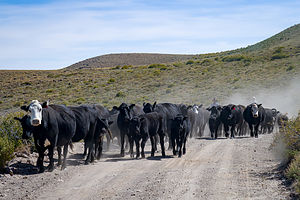 Traffic jam on the road to BodieOnce they had passed, we cleaned our windshield of dust and continued on our way. Before long, the many surviving structures of the old town of Bodie lay before us. What an awesome way to arrive.
Traffic jam on the road to BodieOnce they had passed, we cleaned our windshield of dust and continued on our way. Before long, the many surviving structures of the old town of Bodie lay before us. What an awesome way to arrive.
For anyone traveling on 395, I highly recommend a side trip to Bodie State Historical Park. I believe it is the best preserved ghost town in all of California, if not the entire West.
The town rose to prominence when mining along the western slope of the Sierras declined, and prospectors moved to the eastern side to search for gold. Sure enough, in 1859, W.S. Bodey and his buddy E. S. “Black” Taylor stumbled upon gold in the hills north of Mono Lake, amounting to millions of dollars in gold and silver. Unfortunately, Bodey froze to death in a blizzard while returning with supplies and never got to enjoy his new-found wealth. The town, with a slight spelling change, is named for him.
Things slowed down for a bit in the 1860s, but then in the mid-1870s a rich strike was made by the Standard Mining Company in the Bodie Hills. Word spread, sparking a rush of people to Bodie. By 1879 the town had a population of about 10,000 people and more than 2,000 buildings, primarily general stores, dance halls, and saloons to keep the miners supplied and entertained. Bodie soon developed a reputation for wildness and lawlessness.
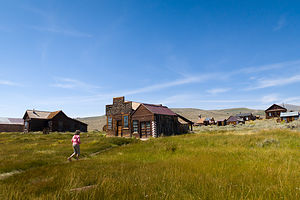 Lolo loose in BodieHowever, by 1881, the mines were depleted and miners and business people left Bodie to follow the next strike. By 1886, the town’s population had fallen to 1,500 people. In the 1890s, the use of electricity as a source of cheap power made mining here profitable again and temporarily boosted it. However, a fire in 1932 destroyed 90% of the town.
Lolo loose in BodieHowever, by 1881, the mines were depleted and miners and business people left Bodie to follow the next strike. By 1886, the town’s population had fallen to 1,500 people. In the 1890s, the use of electricity as a source of cheap power made mining here profitable again and temporarily boosted it. However, a fire in 1932 destroyed 90% of the town.
Bodie faded into a ghost town in the 1940s. Fortunately, in 1962, the town was designated a National Historic Site and a State Historic Park and its buildings are preserved in a state of “arrested decay.” The interiors of the buildings are maintained as they were left, still furnished and stocked with goods.
It’s a very poignant experience wandering the deserted streets, peeking in windows, and imagining the lives of those that once lived, played, worked, and died here not all that long ago.
Description
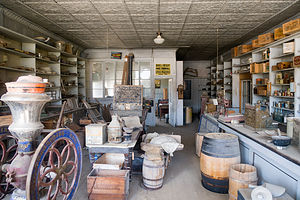 Bodie General StoreBodie State Historic Park is a genuine California gold-mining ghost town. The town rose to prominence when mining along the western slope of the Sierras declined, and prospectors moved to the eastern side to search for gold. A huge strike in Virginia City, the Comstock Lode, brought a wild rush to the high desert country along the eastern Sierras.
Bodie General StoreBodie State Historic Park is a genuine California gold-mining ghost town. The town rose to prominence when mining along the western slope of the Sierras declined, and prospectors moved to the eastern side to search for gold. A huge strike in Virginia City, the Comstock Lode, brought a wild rush to the high desert country along the eastern Sierras.
In 1859, W.S. Bodey and E. S. “Black” Taylor stumbled upon gold in the hills north of Mono Lake, amounting to millions of dollars in gold and silver. Unfortunately, Bodey froze to death in a blizzard while returning with supplies and never got to enjoy his new-found wealth. The town, with a slight spelling change, is named for him.
Things slowed down for a bit in the 1860s, but then in the mid-1870s a rich strike was made by the Standard Mining Company in the Bodie Hills. Word spread, sparking a rush of people to Bodie. By 1879 the town had a population of about 10,000 people and more than 2,000 buildings, primarily general stores, dance halls, and saloons to keep the miners supplied and entertained. Bodie soon developed a reputation for wildness and lawlessness.
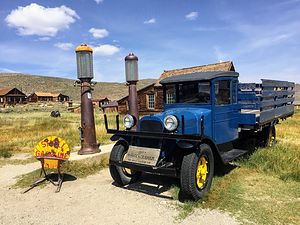
However, by 1881, the mines were depleted and miners and business people left Bodie to follow the next strike. By 1886, the town’s population had fallen to 1,500 people. In the 1890s, the use of electricity as a source of cheap power made mining here profitable again and temporarily boosted it. However, a fire in 1932 destroyed 90% of the town.
Bodie faded into a ghost town in the 1940s. Fortunately, in 1962, the town was designated a National Historic Site and a State Historic Park. Today visitors can walk the streets of this deserted town, which has been preserved in a state of “arrested decay.” The interiors of the buildings are maintained as they were left, still furnished and stocked with goods.
To get there, take U.S. Hwy. 395 to State Hwy. 270 and drive 10 miles east until the paved road ends, then continue for 3 miles of an unpaved dirt road.
- ‹ previous
- 2 of 8
- next ›
Bodie State Historic Park location map in "high definition"
Javascript is required to view this map.
